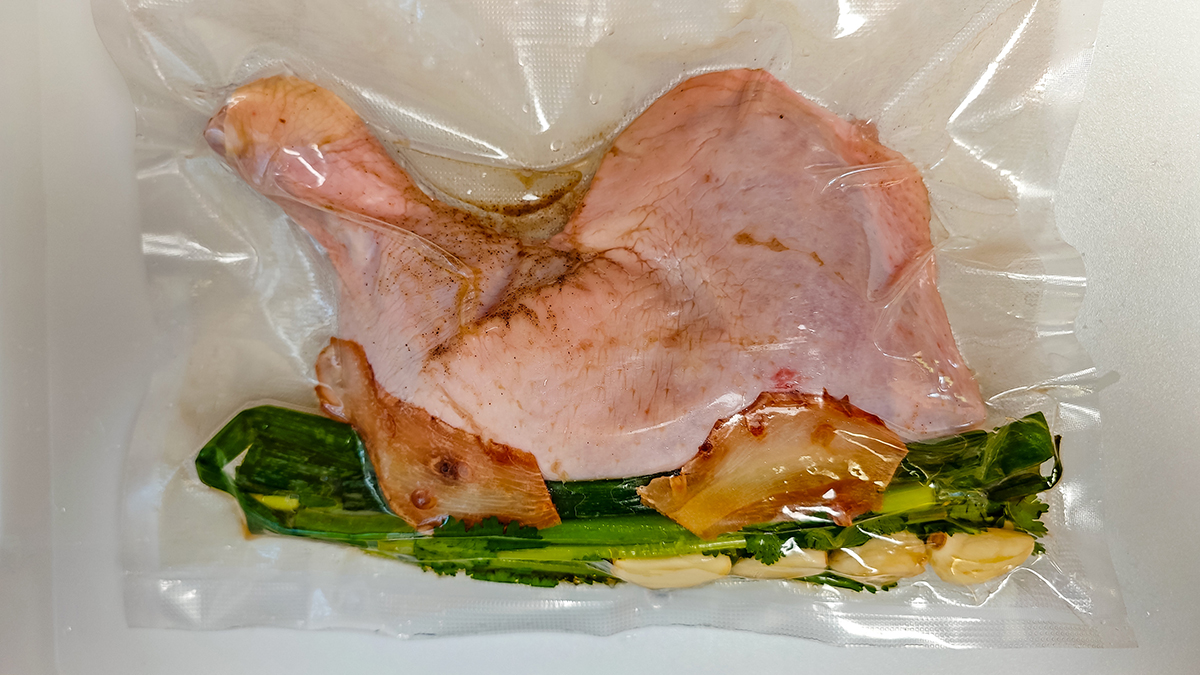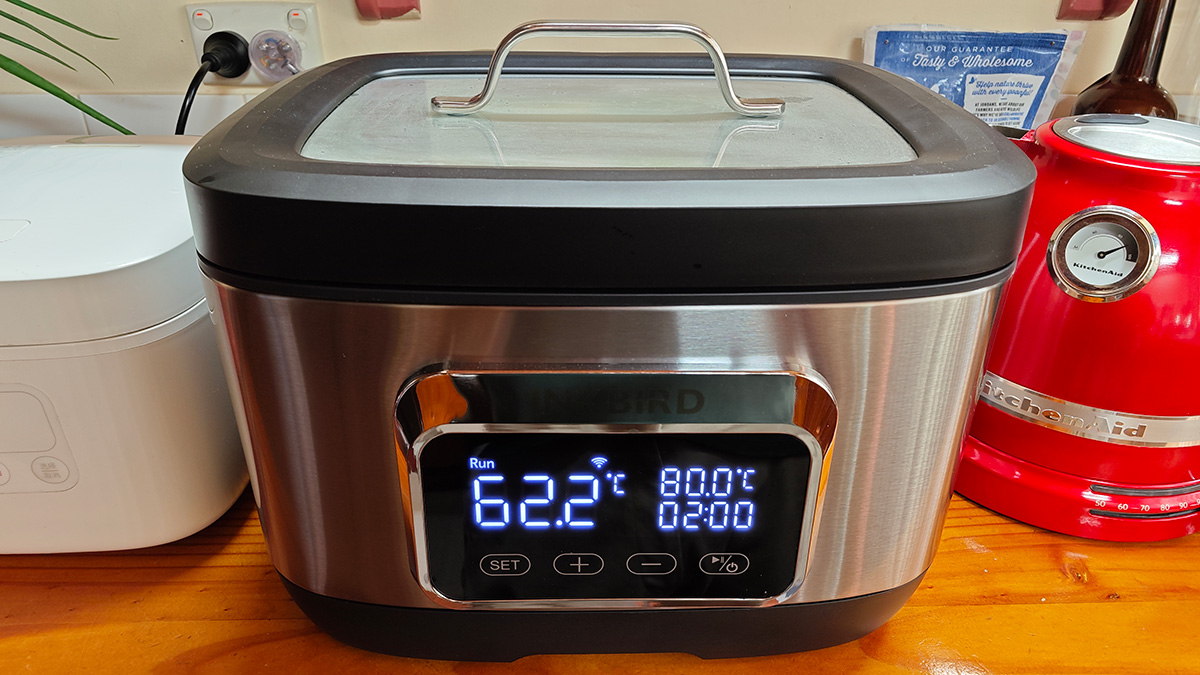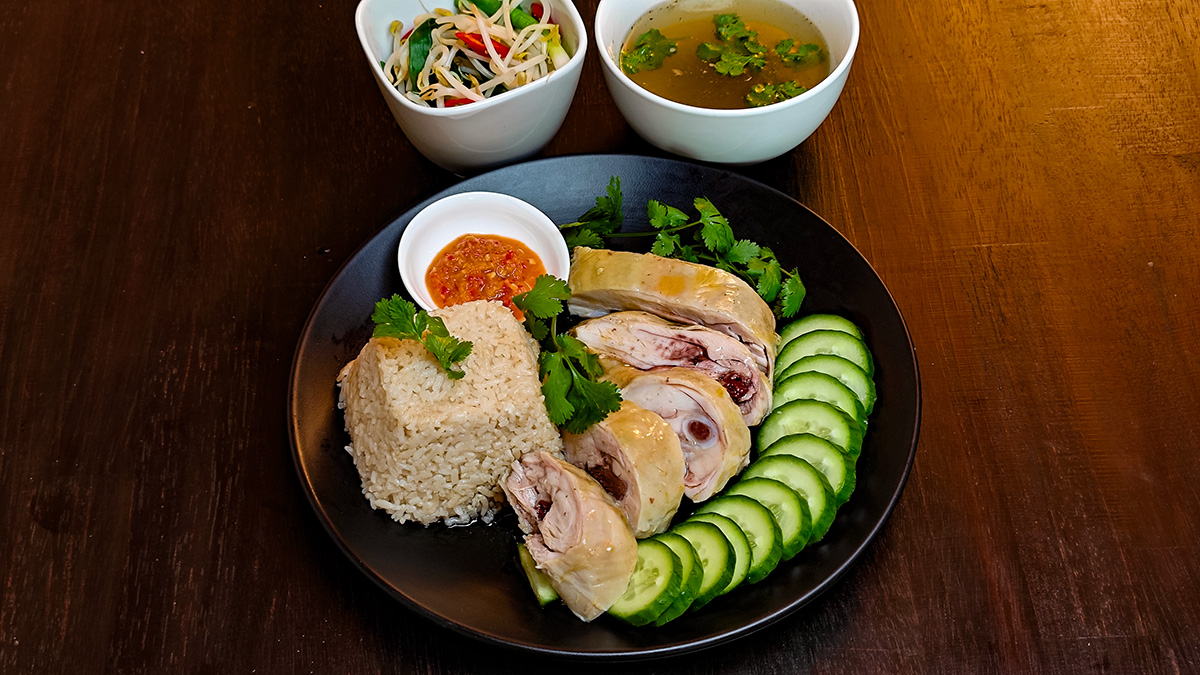Clem's
Sous Vide Hainan Chicken Rice
Sous vide (soo
veed - French for under vacuum) is a cooking method
using a water bath to parboil foods at temperatures lower than
usual for their cooking. This also known as Low-Temperature;
Long-Time Cooking. The food is enclosed in a heat-proof plastic
vacuum bag which is then placed in a bath held at a specific
temperature which practice has shown to reproducibly result in a
tenderly cooked product. For meats the temperature usually tens
of degree centigrade lower than usual. I have had a sous vide
water bath for some months and have only used it a couple of
times, when last night I figured that it would be perfect for
use in cooking Hainan Chicken Rice. This is because in my
method, I only parboil the chicken rather than boil it (see
http://clemkuek.com/photoalbum/photo696y.html). This
to avoid the typical error which people make in making Hainan
Chicken Rice which is to overcook the chicken.
Here is a modified Hainan Chicken Rice method for using a
sous vide water bath:
Consider one Chicken
Maryland (thigh and drumstick) as a single serve.
The following method is based on one serve.
-
In one sous vide vacuum bag, place
-
One chicken Maryland
-
An inch piece of ginger (sliced)
-
Four cloves of garlic (squashed)
-
A helping of spring onions
-
A sprig of coriander (leave this out if you do not like coriander)
-
Ground white pepper to taste
-
A dash of your favourite sesame oil
-
A dash of your favourite fish sauce to taste
-
Some chicken stock powder if you like
-
Add some water as the poaching medium (juices will also exude from the chicken during cooking)
-
Optionally, you can also add a piece of pandan (screwpine) leaf.
-
-
Exclude most of the air in the bag and seal it.

A piece of raw chicken
Maryland with flavouring herbs vacuum bagged ready for sous
vide cooking
-
Fill the water bath with the required amount of water which will completely immerse the chicken.
Let the water bath come to 80°C.
The temperature is critical because:
-
It determines the tenderness of the chicken when cooking is done.
80°C is twenty degrees below boiling and thus, plenty safe from overcooking the chicken.
This temperature is more akin to parboiling.
-
Food held at a warm temperature can incubate microbial pathogens.
80°C is well above the USDA recommended minimum temperature (73.9°C) for cooking chicken and it is also above pasteurization temperature for milk (see below).
-

Bagged chicken in
the sous vide waterbath
-
Place the bagged chicken into the water bath and let it "cook" for 60 minutes.
"Cooking" time is also critical because:
-
Sufficient time is needed for the meat to tenderize at the set temperature (connective tissue looses integrity and renders the overall meat structure more tender).
-
Cooking must be held at the set temperature for a sufficient time to inactivate any viable microbial cells in the product being cooked.
Milk pasteurization is done at not less than 62.8°C for at least 30 minutes (the Holder Method). Thus, 60 minutes at 80°C provides for a wide safety margin.
-

Sous vide waterbath coming to the set temperature on 80°C
-
In the meantime, cook the rice as per normal except that you add Hainan chicken rice paste to it, or make your own by frying (preferably in chicken fat), minced garlic, minced ginger and some chicken stock powder and salt (to taste). Also add a piece of pandan leaf if so inclined.
-
After 60 minutes in the water bath at 80°C, release the chicken from the bag, collect the juices from the bag to make into a chicken soup to accompany the dish.
-
Let the chicken come to room temperature (or set it is a refrigerator to speed up cooling) before chopping it up to serving portions.
Chopping hot or warm chicken pieces will end up messy.
-
Garnish with a sprinkling of sesame oil, and coriander leaf, and you are done.

Clem's sous vide Hainan Chicken Rice as served
You can experiment with
cooking time to get an end result with your desired degree of juiciness
and "doneness" (in terms of red juices out-flowing) by reducing
the time from 90 minutes. However, keep the time to at least 30
minutes for microbial safety.
The inventive ones in you can imagine how to cook this without
vacuum-bagging (just a plastic bag) and without a sous vide
water bath (just a pot with hot water to correct temperature
exchanged as needed)
Enjoy!
21 April
2024
Created by Clem Kuek
